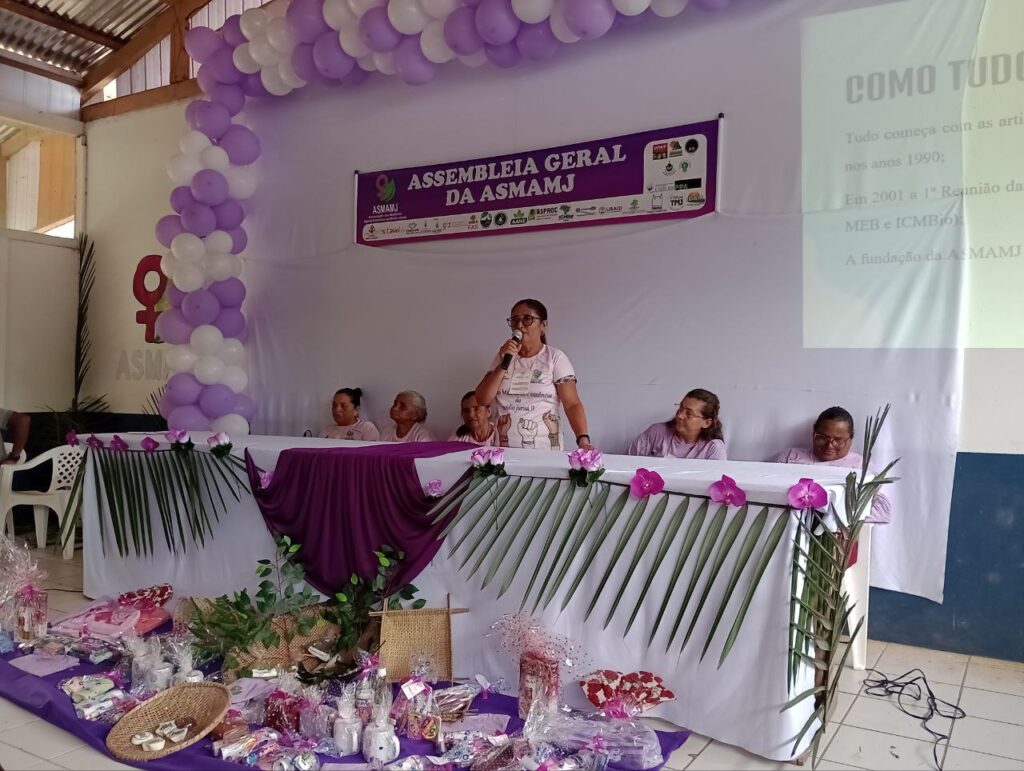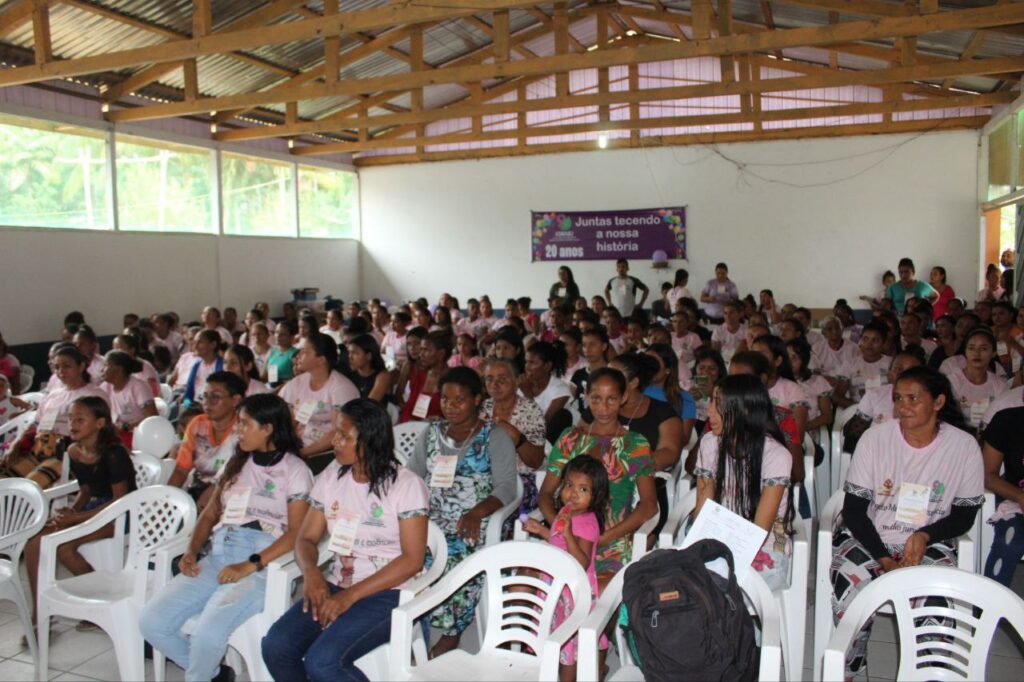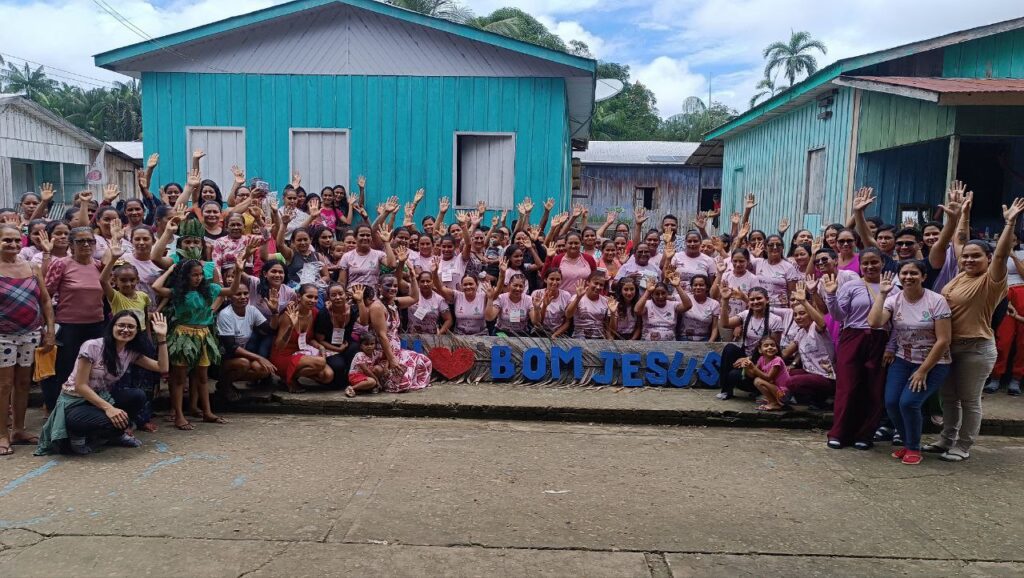Women’s association holds its 11th General Assembly and celebrates its history of struggles and achievements, with more than 200 participants from Mid-Juruá.
By Association of Agroextractivist Women of Médio Juruá (ASMAMJ)
Translated by Bruna Favaro
The Association of Agroextractivist Women of Médio Juruá – ASMAMJ – is a community-based organization that fights for the valorization of women and their guaranteed access to public policies, rights and citizenship, promoting female participation in the social, political and economic spheres in their communities and in the territory as a whole. The association was born from the desire of women living in conservation units (CUs), after having their right to land guaranteed in the CUs, to fight for their rightful space.
The Mid-Juruá Territory, as well as other areas of Northern Brazil, has its history marked by the rubber cycles. The rubber barons exploited the rubber tappers with work regimes similar to slavery. Families were forced to buy basic survival items for absurd prices in sheds or in trading boats (regatões). So, over time, women developed their own strategies, using traditional knowledge passed down from generation to generation, to take care of themselves and their families’ well-being.

After decades of suffering from exploitation, with the support of the Basic Education Movement (MEB), the population began to organize themselves to claim the right to land and their own existence. Thus, the first local association was created in 1994 – ASPROC (Association of Rural Producers of Carauari). ASPROC was fundamental in guaranteeing the communities’ independence from the bosses’ domain and was crucial for fighting for people’s demands in an official way.
As a result of the sufferings mentioned above, in 1997, Médio Juruá Extractive Reserve (RESEX Médio Juruá) was created and, in 2005, Uacari Sustainable Development Reserve (RDS Uacari) was assembled, two significant steps towards guaranteeing the territory to the true owners of the land.
In this scenario, women were always present, however, they had little space. They were deprived of participating in deliberative moments and were also very restricted to the domestic environment. And this reality began to bother them. Therefore, in an organized way and with the support of institutions such as MEB – which highlighted women as a priority in its last cycle of action, and ICMBio (Instituto Chico Mendes of Biodiversity Conservation), through its manager at the time, Rose Batista, an important authority within the process – , women in the territory were able to organize themselves and began to claim their rightful space, reporting the violence and the silencing, seeking their freedom and autonomy of active participation and, mainly, seeking their right for financial independence, as until then, they were not seen by their husbands as people with rights and a voice of their own
Thus, the first meeting of women from Mid-Juruá took place in 2001. There, the commitment to create ASMAMJ was made. During the initial process, there were many difficulties in formalizing the association due to bureaucracy and, mainly, logistical issues, as women did not have the resources to travel to the city to go to the registry office, nor were they able to maintain a representative at the city for many days.
Another challenge faced by the first presidents of the association was regarding schooling, as during that period few women were literate. However, with the support of MEB, ICMBio and later the State University of Amazonas (UEA) and other partners, in 2004, the association was formalized, representing a new moment for women, who strongly yearned for a space that welcomed and represented them.
The association currently operates in the communities of RESEX Médio Juruá, RDS Uacari, the Lower Carauari Fishing Agreement Area and the Kanamari Indigenous Village, in the municipality of Carauari, state of Amazonas. It has 215 members who work in production centers, generating income for its participants. Furthermore, the association carries out actions that value traditional knowledge, the promotion of rights and gender equality.

During the ASMAMJ General Assembly, held between March 6th and 8th, 2024, in Bom Jesus community, the women founders present were able to share, with the members and guests, a little about what the process was like. They recalled some difficulties in getting together, such as rowing to get to meetings – meanwhile, today ASMAMJ has its own vessel and also can count on the availability of partner boats. They also reported that, at the beginning, they did not know about the procedures for legalizing the association, but, with the help of partners, such as Rose Batista, they managed to get it properly regulated. The current director, Olívia, from the Pupuaí community, who was part of the beginning of the organization, recalled the first assembly held in Bom Jesus community. Olívia also encouraged the members not to give up and to always move forward. She mentioned her mother – who has already passed away – who also fought for ASMAMJ.
To add to the history narrated by the association’s pioneers women, Maria Luci stated that “ASMAMJ was created to free women from their ‘husband’s clutches’ in search of their independence, rights and empowerment”. For Maria das Neves, from Novo Horizonte community, the current director of ASPROC and has just finished a term as director of ASMAMJ: “they [women] achieved their space in society as women, because in meetings in the past, men represented the communities, while women stayed at home.” Neves states that there were many difficulties, and that some of the founders have already passed away, but that the message is that one should not give up, that “the association is strengthened and the path is filled with continuous strengthening”.
The recently elected vice-president of ASMAMJ, Ivanete Marreira Figueiredo, from the Xibauá community, encouraged young people to continue with the work that was started by those very strong women. Marta Salvino, from the Roque community, recalled that her community has participated in the creation of the association since the beginning. She emphasized the joy of seeing ASMAMJ with so many members now and highlighted the need to create a women’s organization, given that, at that time, ASPROC was considered by many to be an association made up mostly of men, and that women had no space for leadership. Currently, Marta and her daughters are members of ASMAMJ, and she proudly says that “a woman’s place is wherever she wants”. She stated that there are still women who do not participate in meetings and assemblies because their husbands do not give permission. Therefore, we must fight to prevent this from happening again.
On June 16, 2024, the organization will complete 20 years of existence. The founders are grateful for the work that has been carried out by the current leadership, made up of young and empowered women. They have been continuing this work of countless struggles and have been climbing along a path of many achievements.

As a result of this work, the association currently has production centers, such as the artisanal extraction of andiroba, production of biocosmetics and soap, and production of biojewelry with locally managed fish scales. Furthermore, ASMAMJ is seeking to consolidate the extraction of essential oil from plants in the region and, in partnership with Natura, will develop a mutamba production chain, to be used in the manufacture of the company’s products. This partnership is already being developed with other associations in the territory.
Furthermore, the association has a technical team that assists in carrying out activities and in developing projects, thanks to partnerships with institutions such as Sitawi, Fundo Casa, Benefit Sharing Fund, Memorial Chico Mendes, UNDP, among others. The current headquarters of ASMAMJ is located in the community of São Raimundo (RESEX Médio Juruá) and has a Distillation House, office, boat with motor for displacement, office supplies, among other assets that are the results of 20 years of work.
Their desire is to have its own headquarters in the city of Carauari, since today the association shares the same historic building with Instituto Juruá. In the past, the building housed the CNS (National Council of Extractive Populations). We believe that with ASMAMJ’s own headquarters, the needs of women in Mid-Juruá would be better met with the services offered by the association, such as psychological assistance and product sales in their own, identity-based space.
Even in the face of so many achievements, there are still challenges to be overcome, such as the low participation of women in decision-making spaces, such as in the Reserve Management Council (RDS and RESEX), where, basically, all socio-environmental agendas in the Mid-Juruá Territory are decided. However, it is expected that with training in Territorial Management for women – which will be carried out by ASMAMJ – among other services planned for 2024, they will be able to become even more empowered and to represent their communities in all the spaces they wish to occupy.